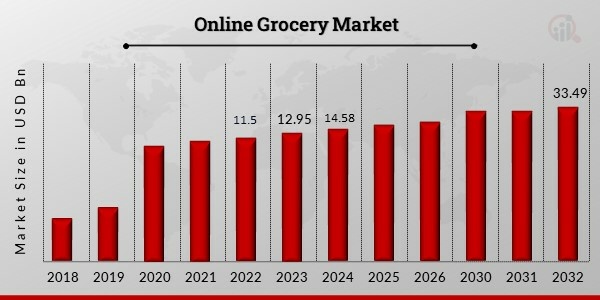Online Grocery Industry Growth and Trends
The Online Grocery Market Size was estimated to be worth USD 12.95 billion By 2023. With a compound annual growth rate (CAGR) of 10.95% from 2024 to 2032, the online grocery market industry is expected to increase from USD 14.582995 billion in 2024 to USD 33.49 billion by 2032. The main factors propelling market expansion are consumers’ growing inclination for online shopping portals and the growing use of contactless payment methods.

The online grocery market has experienced exponential growth, driven by factors such as increased internet penetration, smartphone adoption, and the rising preference for digital transactions. The COVID-19 pandemic accelerated this trend, pushing consumers to adopt online grocery shopping at an unprecedented rate. As a result, grocery retailers and e-commerce giants have invested heavily in enhancing their digital infrastructure, optimizing supply chains, and expanding their delivery capabilities.
Subscription-based grocery services and direct-to-consumer (DTC) models have gained popularity, allowing consumers to schedule regular deliveries and reduce the hassle of frequent store visits. Additionally, the integration of artificial intelligence (AI) and machine learning (ML) in online grocery platforms has improved personalized recommendations, streamlined inventory management, and enhanced customer experiences.
“Free Sample Copy” – Access a complimentary copy of our report to explore its content and insights
https://www.marketresearchfuture.com/sample_request/9626
Key Drivers of Market Growth
- Convenience and Time-Saving Benefits – Consumers prefer online grocery shopping due to its convenience, eliminating the need for in-store visits, long checkout lines, and transportation hassles. With just a few clicks, shoppers can order groceries from the comfort of their homes.
- Wide Product Selection – Online grocery platforms offer an extensive range of products, including fresh produce, packaged goods, organic items, and specialty foods. This variety appeals to customers seeking specific dietary preferences and niche brands.
- Contactless Shopping Experience – Health concerns and safety precautions have encouraged consumers to adopt contactless shopping, further boosting the demand for online grocery services. Features such as contactless payment and doorstep delivery have become essential offerings.
- Technological Advancements – The integration of AI, big data, and predictive analytics has revolutionized inventory management and demand forecasting. Automated warehouses and robotic fulfillment centers are optimizing order processing and reducing operational costs.
- Strategic Partnerships and Expansions – Major grocery retailers have collaborated with technology companies and third-party delivery services to strengthen their online presence. Companies like Amazon Fresh, Walmart+, and Instacart have expanded their services to cater to a growing customer base.
Challenges Facing the Online Grocery Market
Despite its rapid growth, the online grocery market faces several challenges that retailers must address to sustain profitability and ensure seamless operations.
- Logistics and Supply Chain Complexity – Managing perishable and fresh produce while maintaining timely deliveries poses logistical challenges. Efficient supply chain management is crucial to prevent food spoilage and reduce waste.
- High Operational Costs – The costs associated with warehousing, packaging, and last-mile delivery can impact profit margins. Retailers must balance affordability with operational efficiency to remain competitive.
- Consumer Trust and Quality Assurance – Some customers hesitate to purchase groceries online due to concerns about product quality, freshness, and misrepresentation. Retailers must implement strict quality control measures and ensure transparency in product descriptions.
- Competition and Market Saturation – The online grocery sector is highly competitive, with new entrants constantly emerging. Companies must differentiate themselves through superior customer service, loyalty programs, and innovative features.
- Regulatory Compliance and Food Safety Standards – Adhering to food safety regulations and ensuring compliance with local laws can be challenging, particularly for cross-border grocery platforms.
“Proceed to Buy” – Move forward with your purchase and gain instant access to the complete report
https://www.marketresearchfuture.com/checkout?currency=one_user-USD&report_id=9626
The Role of AI and Automation
AI and automation are playing a transformative role in the online grocery industry, enhancing efficiency and customer experience. AI-powered chatbots assist customers with order inquiries, while predictive analytics help retailers anticipate demand and stock inventory accordingly. Automated warehouses and robotic picking systems reduce labor costs and improve order accuracy, ensuring faster deliveries.
Furthermore, AI-driven recommendation engines personalize shopping experiences by suggesting products based on previous purchases and browsing behavior. Voice-assisted grocery shopping, facilitated by smart speakers like Amazon Alexa and Google Assistant, has also gained traction, making grocery ordering more convenient than ever.
The Future of the Online Grocery Market
The future of the online grocery market looks promising, with continued advancements in technology and consumer preferences shaping its trajectory. Some notable trends expected to influence the industry include:
- Expansion of Quick Commerce (Q-Commerce) – The demand for ultra-fast delivery services (within 10-30 minutes) is rising, leading to the growth of Q-commerce platforms. Companies are investing in micro-fulfillment centers and dark stores to facilitate rapid deliveries.
- Growth of Sustainable and Eco-Friendly Practices – Consumers are increasingly prioritizing sustainability, pushing online grocery platforms to adopt eco-friendly packaging, reduce plastic waste, and source ethically produced products.
- Rise of Online-Only Grocery Stores – Several companies are launching digital-first grocery stores without physical locations, focusing entirely on online fulfillment and delivery services.
- Integration of Augmented Reality (AR) and Virtual Reality (VR) – AR and VR technologies are expected to enhance the online shopping experience, allowing customers to inspect products virtually before making a purchase.
- Blockchain for Transparency and Traceability – Blockchain technology is being explored to improve transparency in the supply chain, ensuring food safety and authenticity.
Discover more Research Reports on Consumer-and-Retail Industry, by Market Research Future:
Luxury Fashion Market Research Report Forecast Till 2032
Artificial Plants Market Research Report Forecast Till 2032
Hair Extension Market Research Report Forecast Till 2032
Knitwear Market Research Report Forecast Till 2032
Karaoke Market Research Report Forecast Till 2032
About Market Research Future:
Market Research Future (MRFR) is a global market research company that takes pride in its services, offering a complete and accurate analysis with regard to diverse markets and consumers worldwide. Market Research Future has the distinguished objective of providing optimal quality research and granular research to clients. Our market research studies by products, services, technologies, applications, end users, and market players for global, regional, and country level market segments, enable our clients to see more, know more, and do more, which help answer your most important questions.
Contact Us:
Market Research Future (Part of Wantstats Research and Media Private Limited) 99 Hudson Street, 5Th Floor New York, NY 10013 United States of America +1 628 258 0071 (US) +44 2035 002 764 (UK) Email: info@marketresearchfuture.com Follow Us: LinkedIn | Twitter
Website: https://www.marketresearchfuture.com/
https://www.wiseguyreports.com/
Media Contact
Company Name: Market Research Future
Contact Person: Media Relations
Email: Send Email
Country: United States
Website: https://www.marketresearchfuture.com

